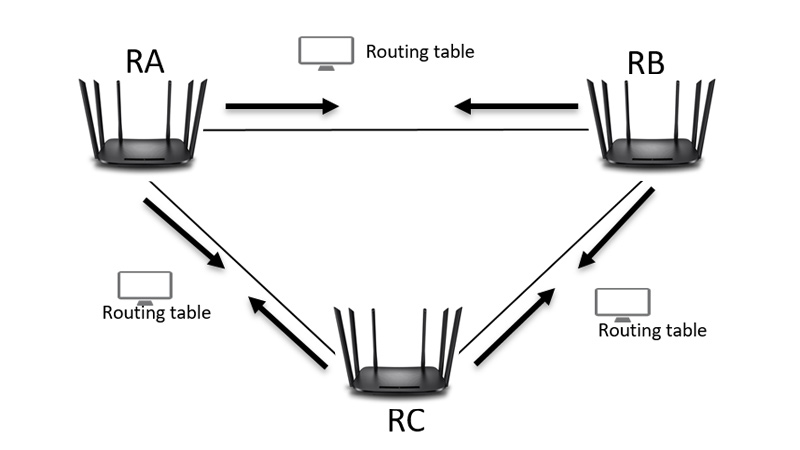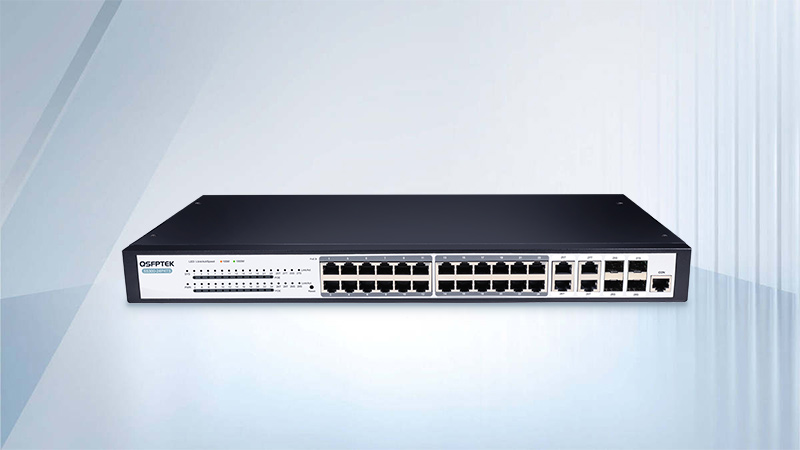RIP vs. OSPF: Different Routing Protocols Comparison
RIP is a distance-vector routing protocol, but OSPF is gradually replacing it due to its slow convergence, susceptibility to routing loops, and lack of scalability. This article explores the differences between RIP and OSPF.
RIP and OSPF are two common Interior Gateway Protocols (IGPs) widely used in computer networks to select the optimal path for data transmission. The RIP is one of the oldest existing routing protocols, whereas OSPF is the most commonly used IGP in large enterprise networks. The main difference between these two protocols is that RIP uses the distance-vector algorithm for routing, whereas OSPF is the most commonly used IGP in large enterprise networks. The main difference is that RIP uses a distance vector algorithm for routing, while OSPF relies on a link-state algorithm.
What is Routing Information Protocol (RIP) in Networks?
Routing Information Protocol (RIP) is a distance-vector protocol that measures a route's merit primarily by the number of hops. It clearly defines how routers should exchange information when passing traffic between a set of interconnected LANs.
The OSPF routing protocol is now the most commonly used interior gateway protocol in enterprise networks, having replaced RIP in many cases. This shift is undoubtedly due to RIP's simplicity and limitations when dealing with large, complex networks. The Border Gateway Protocol (BGP) is a path-vector routing protocol that is now the primary method for passing routing information between autonomous systems on the Internet.
RIP was initially designed for the Xerox PARC Generic Protocol and first appeared as GWINFO in the Xerox Network Systems Protocol Suite in 1981. It was formally defined in RFC 1058 in 1988 and is renowned for its simplicity of configuration and particular suitability for use in small networks.
The Routing Information Protocol (RIP) Working Principle
Using a distance vector algorithm, RIP determines the paths that packets take to reach their destinations. Each RIP router maintains a routing table that lists all the destinations that the router can access. Every 30 seconds, the router broadcasts the entire routing table to its nearest neighbors. In this context, “neighbors” refers to other routers directly connected to the router and located on the same network segment. These neighbors continue to pass on the information they receive to their neighbors, and so on, until all RIP devices in the network share the same routing information, a process known as “convergence”.
When a router receives a routing update, if it finds that the new path is shorter, it modifies the routing table entry with the updated path length and next-hop address. If the new path is longer, the router waits a “hold” time to verify that the next update shows the longer path. The router will update the table entry only when it is sure that the new longer path has stabilized.
Suppose a router fails or the network connection is interrupted. In that case, the network will notice the problem because the router has stopped sending updates to its neighbors or cannot send and receive updates on the interrupted connection. If a route is not updated in the routing table for six consecutive update cycles (180 seconds), the RIP router deletes the route and informs the rest of the network of the change through its periodic updates.

What is Open Shortest Path First (OSPF) in Networks?
OSPF is an IP routing protocol that calculates the most efficient traffic path in an IP network using a mathematical algorithm. OSPF is an open standard specified by the Internet Engineering Task Force (IETF) and is one of several Interior Gateway Protocols (IGPs) in the TCP/IP family of protocols.
OSPF propagates routing information between routers within a single autonomous system (AS) based on link-state or shortest path first (SPF) techniques. This feature allows OSPF to cope with the complexity of modern networks, unlike traditional TCP/IP routing protocols designed for simpler networks.
OSPF uses Dijkstra's shortest path algorithm to calculate the shortest paths between all routers in an AS area, resulting in efficient network bandwidth utilization and good scalability. An AS can be divided into multiple interconnected networks, such as a WAN, but the topology information is limited to routers within the same area.
As a dynamic routing protocol, OSPF routes IP packets by using the destination IP address in the packet header and also detects topology changes within the AS. Once a change is detected, OSPF calculates a new loop-free path within a short convergence time, ensuring minimal disruption to network traffic.
In an OSPF network, all routers in the same area maintain the same link-state database, which records the area's topology. Each router receives link-state announcements (LSAs) containing neighbor information and path costs from other routers in the area. Based on these LSAs, each router constructs a link state database and computes a shortest path spanning tree using the SPF algorithm.
The Open Shortest Path First (OSPF) Working Principle
In OSPF, two key concepts are areas and neighbors.
An area is a group of routers within an autonomous system (AS) that together form a partition with logical boundaries, usually identified by a number. Area 0 is the backbone area, and all other areas must connect to it.
OSPF-enabled routers establish neighbor relationships within the same area by sending HELLO packets to exchange routing information. Updates are sent only when there is a change in routing or network state.
An OSPF router immediately multicasts changes to the routing table or network topology to all OSPF-enabled nodes in the area when a change is detected. This multicasting mechanism guarantees that every router in the area has access to the same AS topology information, a process known as flooding. Routers use this information to calculate the best path from the source to the final destination within the AS.
It is crucial to understand that OSPF's multicast transmits only the latest update, not the entire routing table. Given the vast size of routing tables, transmitting the complete routing table each time can significantly impact network performance. When routes change (due to device failure or the addition of a new device, for example), the OSPF router coordinates these changes and determines new loop-free paths within a certain convergence time to ensure optimal connectivity between endpoints.
The Detail Comparison of OSPF vs. RIP
Types of Routing Protocols
RIP is a distance vector protocol that determines the path for data transmission mainly by calculating the number of hops. OSPF is a link-state protocol that goes beyond simply analyzing the number of hops. It also considers factors like speed, cost, and path congestion to select the optimal path.
Routing Table Construction
In RIP, a router requests routing table information from surrounding devices and then merges it into its routing table. The updated routing table is sent to neighboring devices regularly to guarantee that all devices have the latest routing information. OSPF's routing table construction is more granular. Routers obtain only the necessary information from neighboring devices, rather than requesting the entire routing table. This makes updating its routing table simpler and more efficient.
Hop Count Limit
RIP has a strict limit on the number of hops, allowing a maximum of 15 hops. This makes it unsuitable for larger networks. OSPF has no limitations and can support more complex and larger network structures.
Algorithm Differences
RIP uses a distance vector algorithm to select paths, whereas OSPF utilizes Dijkstra's shortest path algorithm to calculate routes. This makes OSPF the more efficient choice when dealing with complex networks.
Network Classification
The RIP network structure is relatively simple. It is usually divided into areas and tables. OSPF, however, is more complex and adaptable because it divides the network into areas, sub-areas, autonomous systems, and backbone areas.
Complexity
OSPF is more complex than RIP. RIP is simple to configure and manage, but it has limited ability to scale to large networks. OSPF is suitable for larger networks because it can handle complex topologies.
Do You Need an OSPF or RIP Switch?
RIP and OSPF are two dynamic routing protocols that are more scalable than static routing and can automatically respond to changes in the network topology (e.g., component failures). In the event of a network problem, these protocols can automatically reroute traffic through alternate paths to minimize service interruptions. If you are looking for a switch that supports RIP and OSPF, QSFPTEK offers a cost-effective alternative. QSFPTEK's enterprise-class switches, such as the L3 Fully Managed 10G Switch, support the full range of IPv4 routing protocols, including RIP, OSPF, BGP, and ECMP. In addition, QSFPTEK offers high-performance, affordable data center switches, and Gigabit PoE switches to customers worldwide.

Conclusion
By comparing the different characteristics of RIP and OSPF, it is clear that RIP is better suited for small networks with simple structures, while OSPF is more suitable for large, complex, and hierarchical enterprise networks. In some complex network environments, it may be necessary to run multiple routing protocols simultaneously. We hope you find the most suitable configuration for your network.










